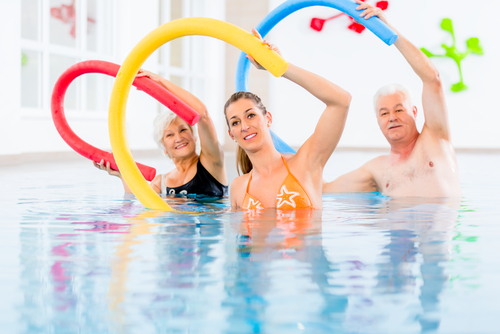Hydrotherapy — physical exercise performed in water — can effectively improve clinical symptoms of fibromyalgia only if performed continuously.
That finding was drawn from data collected in a randomized, controlled trial, reported recently in the study “Effects of aquatic training and detraining on women with fibromyalgia: controlled randomized clinical trial.” The study was published in the European Journal of Physical and Rehabilitation Medicine.
Several non-pharmacological strategies have been proposed to manage fibromyalgia symptoms. Despite some controversies, several studies have demonstrated that physical activity can effectively help reduce some symptoms of the disease.
Among the non-pharmacological possibilities is aquatic physical training, or hydrotherapy, which consists of an aerobic physical training program that is conducted in a heated pool. This alternative treatment option reduced pain and improved the quality of life of fibromyalgia patients.
To have a better understanding of the benefits of hydrotherapy, Brazilian researchers conducted a controlled trial. The study (NTC01839305) enrolled a total of 54 women with clinically diagnosed fibromyalgia who were randomly assigned to undergo hydrotherapy or just perform their normal daily life activities.
The training program consisted of 32 sessions of 45 minutes, twice a week, for a total of 16 weeks. Each session included a 10-minute warm-up phase, 30 minutes of intense exercise, and five minutes of relaxation exercises.
After completion of the program the participants were followed for an additional 16-week period during which they were requested to keep their physical activity to low levels (irregularly active or sedentary).
The researchers evaluated changes in oxygen uptake relative to lean body mass, as a measure of aerobic capacity, after hydrotherapy and detraining periods. Also, changes in clinical manifestations of fibromyalgia and general health status were assessed by the Fibromyalgia Impact Questionnaire (FIQ) and the Medical Outcomes Study 36-item Short Form Health Survey (SF-36).
After 16 weeks of hydrotherapy training the participants showed a significant improvement in their aerobic capacity compared to baseline levels, and compared to those in the control group. Also, after the training program the patients said they experienced less fatigue and anxiety, and improved well-being, functional capacity, and vitality.
The patients showed a 7% reduction in pain scores, 192% increase in SF-36 physical function, and a reduction of 19% in FIQ score after completion of the 16 weeks of therapy.
However, these positive effects were lost during the following 16 weeks, in which the participants stopped the training program. Their oxygen uptake levels returned to baseline values, as well as many of their clinical manifestations of the disease.
The researchers did not find any association between improved aerobic capacity and reductions of clinical manifestations of fibromyalgia.
Supported by these results, the team believes that aquatic physical training “should be continuously performed in order to improve clinical symptomatology and increase the aerobic functional capacity” of those living with fibromyalgia.

